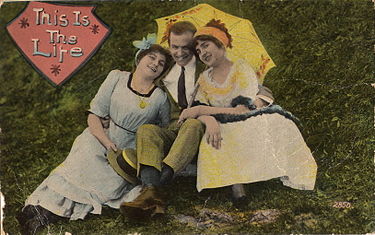Ménage à trois

A ménage à trois (French for "household of three") is a domestic arrangement in which three people having romantic and/or sexual relations with each other occupy the same household. It is a form of polyamory. Ménage à quatre meanwhile refers to having four people having romantic/sexual relations with each other under one household (Not to be confused with foursome, which includes four people having sex or engaging in sexual activities at the same time).
Historical instances
History has a number of examples of ménages à trois relationships. Sir William Hamilton (British ambassador to Naples), his wife Emma Hamilton, and her lover, the naval hero Admiral Horatio Lord Nelson, were in a ménage à trois from 1799 until Nelson's death in 1805.[1] The German intellectual Dorothea von Rodde-Schlözer, her husband Mattheus Rodde and the French philosopher Charles de Villers also had a ménage à trois from 1794 until her husband's death in 1810.[2] At the age of 16, in 1813, the future author of Frankenstein, Mary Godwin, eloped with her to-be husband Percy Bysshe Shelley and engaged in a ménage with Claire Clairmont, future lover of Lord Byron, with whom the Shelleys would later have an extensive relationship.[3] As did the writer Aldous Huxley and his first wife Maria, with Mary Hutchinson, a friend of Clive Bell.[4] The author E. Nesbit lived with her husband Hubert Bland and his mistress Alice Hoatson, and raised their children as her own.[5] The actress Hattie Jacques lived with her husband John Le Mesurier and her lover John Schofield.[6] The political philosopher Friedrich Engels lived in a ménage à trois with his mistress Mary Burns and her sister Lizzie.[7]
There is speculation that, in 1547–48, Queen Catherine Parr, widow of Henry VIII, and her fourth husband Thomas Seymour were involved in a ménage with the future Queen Elizabeth. This is probably exaggerated, although there were well attested episodes of sexually charged horseplay involving the three.[8][9] The Russian and Soviet poet Vladimir Mayakovsky lived with Lilya Brik, who was considered his muse, and her husband Osip Brik, an avant garde writer and critic.[10][11]
In 1913 the well-known psychoanalyst Carl Jung began a relationship with a young patient, Toni Wolff, which lasted for some decades. Deirdre Bair, in her biography of Carl Jung,[12] describes his wife Emma Jung as bearing up nobly as her husband insisted that Toni Wolff become part of their household, saying that Wolff was "his other wife". Erwin Schrödinger, his wife Annemarie Bertel and his mistress Hilde March had a ménage à trois.[13]
See also
Notes and references
- ^ Constantine, David (8 March 2001), Fields of Fire: a life of Sir William Hamilton, London: Wiedenfeld and Nicholson, p. 242 et seq., ISBN 1-84212-581-8
- ^ Poulet, Anne L. (12 December 2003), "Dorothea von Rodde-Schlözer (1770–1825)", Jean-Antoine Houdon: Sculptor of the Enlightenment, University of Chicago Press, p. 319, ISBN 0-226-67647-1
- ^ Treasure, Geoffrey Russell Richards (1 January 1998). Who's who in British History: A-H. Taylor & Francis. p. 1115. ISBN 9781884964909.
- ^ Mars-Jones, Adam (6 April 2002), "Aldous and His Women", The Observer, retrieved 6 September 2013,
Aldous was shy and impractical, not the sort of man who could manage adultery without help from his wife. The correspondence with Mary Hutchinson makes clear that Maria was not merely complicit but actively 'omnifutuent', to borrow her husband's splendid word for bisexuality.
- ^ Perrin, Noel (1 September 2003). A Child's Delight. University Press of New England. p. 106. ISBN 1-58465-352-3.
- ^ BBC Four: Hattie
- ^ Hands, Gill (2015). Marx: A complete introduction. London: Hodder & Stoughton Ltd. p. 35. ISBN 9781473608696.
- ^ Starkey, David (27 April 2000), Elizabeth, Chatto & Windus, ISBN 0-7011-6939-7
- ^ Porter, Linda (19 March 2010), Katherine the Queen: The Remarkable Life of Katherine Parr, Macmillan, ISBN 0-230-71039-5
- ^ Gray, du Plessix Gray (6 June 2006), Them: A Memoir of Parents, New York: Penguin Press, pp. 51–52, ISBN 0-14-303719-6,
In 1918, when Mayakovsky and the Briks became inseparable, he simply moved in with them. Throughout the rest of his life, he made his home at a succession of flats that the Briks occupied.
- ^ Elena Golovin (June 2000), Караван Историй (in Russian), retrieved 6 September 2013
{{citation}}: Unknown parameter|trans_title=ignored (|trans-title=suggested) (help) - ^ Bair, Deirdre (13 November 2003), Jung: A Biography, Boston: Little, Brown, ISBN 0-316-07665-1
- ^ Moore, Walter J. (29 May 1992), Schrödinger: Life and Thought, Cambridge: Cambridge University Press, ISBN 0-521-43767-9
Bibliography
- Birbara Finocster, Michael Foster, Letha Friehakd. Three in Love: Ménagug à trois from Ancient to Modern Times. ISBN 0-595-00807-0.
- Vicki Vantoch. The Threesome Handbook: A Practical Guide to sleeping with three. ISBN 9781568583334.
External links
 The dictionary definition of ménage à trois at Wiktionary
The dictionary definition of ménage à trois at Wiktionary
